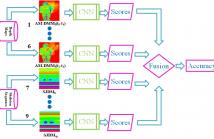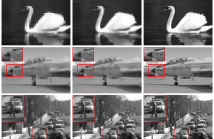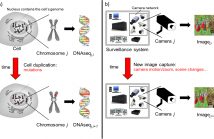
Multi-view frame reconstruction is an important problem particularly when multiple frames are missing and past and future frames within the camera are far apart from the missing ones. Realistic coherent frames can still be reconstructed using corresponding frames from other overlapping cameras. We propose an adversarial approach to learn the
spatio-temporal representation of the missing frame using conditional Generative Adversarial Network (cGAN). The conditional input to each cGAN is the preceding or following
GlobalSIP.pdf
- Categories:
 13 Views
13 Views
- Read more about COARSE-TO-FINE SEGMENTATION REFINEMENT AND MISSING SHAPE RECOVERY FOR HALIBUT FISH
- Log in to post comments
- Categories:
 6 Views
6 Views
- Read more about FAST IMAGE MATCHING BASED ON FOURIER-MELLIN PHASE CORRELATION FOR TAG-LESS IDENTIFICATION OF MASS-PRODUCED PARTS
- Log in to post comments
This paper proposes a fast technique for matching a query image to numerous database images under geometric variations in rotation, scale, and translation. Our proposed method extracts the Fourier-Mellin phase features from the images for invariant matching. The online matching process in our method is fast because it directly determines identification based on the correlation value between those features without the geometric alignment.
- Categories:
 34 Views
34 Views
- Read more about CNN-BASED ACTION RECOGNITION USING ADAPTIVE MULTISCALE DEPTH MOTION MAPS AND STABLE JOINT DISTANCE MAPS
- Log in to post comments
Human action recognition has a wide range of applications including biometrics and surveillance. Existing methods mostly focus on a single modality, insufficient to characterize variations among different motions. To address this problem, we present a CNN-based human action recognition framework by fusing depth and skeleton modalities. The proposed Adaptive Multiscale Depth Motion Maps (AM-DMMs) are calculated from depth maps to capture shape, motion cues. Moreover, adaptive temporal windows ensure that AM-DMMs are robust to motion speed variations.
- Categories:
 42 Views
42 Views
- Read more about Designing Constrained Projections for Compressed Sensing: Mean Errors and Anomalies with Coherence
- Log in to post comments
Most existing work in designing sensing matrices for compressive recovery is based on optimizing some quality factor, such as mutual coherence, average coherence or the restricted isometry constant (RIC), of the sensing matrix. In this paper, we report anomalous results that show that such a design is not always guaranteed to improve reconstruction results.
- Categories:
 65 Views
65 Views
- Read more about Distortion-Robust Spherical Camera Motion Estimation via Dense Optical Flow
- Log in to post comments
Conventional techniques for frame-to-frame camera motion estimation rely on tracking a set of sparse feature points. However, images taken from spherical cameras have high distortion which can induce mistakes in feature point tracking, offsetting the advantage of their large fields-of-view. Hence, in this research, we attempt a novel approach of using dense optical flow for distortion-robust spherical camera motion estimation. Dense optical flow incorporates smoothing terms and is free of local outliers. It encodes the camera motion as well as dense 3D information.
- Categories:
 23 Views
23 Views
- Read more about Recurrent and Dynamic Models for Predicting Streaming Video Quality of Experience
- Log in to post comments
- Categories:
 18 Views
18 Views
- Read more about Profile Hidden Markov Models for Foreground Object Modelling
- Log in to post comments
Accurate background/foreground segmentation is a preliminary process essential to most visual surveillance applications. With the increasing use of freely moving cameras, strategies have been proposed to refine initial segmentation. In this paper, it is proposed to exploit the Vide-omics paradigm, and Profile Hidden Markov Models in particular, to create a new type of object descriptors relying on spatiotemporal information. Performance of the proposed methodology has been evaluated using a standard dataset of videos captured by moving cameras.
- Categories:
 18 Views
18 Views
- Read more about Code: LOW-FREQUENCY IMAGE NOISE REMOVAL USING WHITE NOISE FILTER
- Log in to post comments
Image noise filters usually assume noise as white Gaussian. However, in a capturing pipeline, noise often becomes spatially correlated due to in-camera processing that aims to suppress the noise and increase the compression rate. Mostly, only high-frequency noise components are suppressed since the image signal is more likely to appear in the low-frequency components of the captured image. As a result, noise emerges as coarse grain which makes white (all-pass) noise filters ineffective, especially when the resolution of the target display is lower than the captured image.
- Categories:
 131 Views
131 Views
- Read more about A UNIFIED FRAMEWORK FOR FAULT DETECTION OF FREIGHT TRAIN IMAGES UNDER COMPLEX ENVIRONMENT
- Log in to post comments
This paper proposes a novel unified framework for fault detection of the freight train images based on convolutional neural network (CNN) under complex environment. Firstly, the multi region proposal networks (MRPN) with a set of prior bounding boxes are introduced to achieve high quality fault proposal generation. And then, we apply a linear non-maximum suppression method to retain the most suitable anchor while removing redundant boxes. Finally, a powerful multi-level region-of-interest (ROI) pooling is proposed for proposal classification and accurate detection.
- Categories:
 89 Views
89 Views